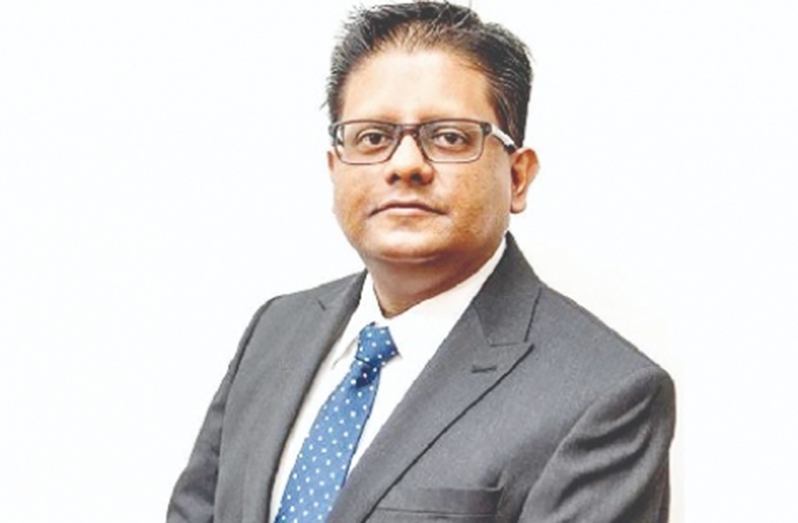
– Dr Singh tells global leaders, outlining plans for human capital development
GUYANA remains the fastest growing economy in the world and will remain among the fastest growing economies over the next few years, said Senior Minister at the Office of the President with responsibility for Finance, Dr . Ashni Singh.
Driven by the country’s nascent but lucrative petroleum sector and other critical investments in productive economic activities, Guyana is forecast to lead global growth, even in the face of climate-related challenges, COVID- 19 and general internal congestion.
Minister Singh, in his address to a virtual conclave on human capital, convened by the World Bank on Monday, said Guyana is rich in natural resources, including oil, minerals, and forests covering 85 percent of territory the country, making its economic prospects very promising despite COVID-19 and domestic political issues that caused a sharp decline in non-oil gross domestic product (GDP) in 2020.
“Our economic outlook has never been brighter. Our collective feet are firmly positioned on the first steps of a ladder to prosperity that is clearly within our reach, ”said President, Dr Irfaan Ali, during his message to the nation on January 1, 2021.
The year 2021, according to the President, will be the starting point for Guyana leaping into recovery, rebuilding the economy, improving the health of the people and lifting the vulnerable in society.
“We must not remain a rich country of poor people,” the President confirmed, noting that Guyana’s bounty must be shared across the population.
Resilience was reported to have been a hallmark of the local economy, as it withstood the direct and indirect effects of the COVID-19 pandemic and the long March 2, 2020 General and Regional Elections, to record real GDP growth of 43.5 percent at the end of last year remains on track to grow another 20.9 percent this year.
Led by the government’s $ 383.1 billion Budget 2021, the economy will continue to drive the pervasive pandemic and, at the same time, improve through prudent management of the productive sectors and the general economy.
But, even with the country’s prospects bright, Dr. Singh told the virtual caucus: “… we also face extreme vulnerabilities to climate change, as well as significant development challenges. We are well aware of the scale of these challenges. They include avoiding the resource curse, promoting a strong and competitive non-oil economy, addressing our infrastructure gap, and improving human development outcomes. “
Speaking on the issue of environmental sustainability, Minister Singh highlighted the role of the original Low Carbon Development Strategy (LCDS) and the possible extended version of this strategy.
LONG
“Guyana’s commitment to low carbon or ‘green’ growth is well established. In 2008, we published what we believe was the first low carbon development strategy for a developing country. The LCDS reflected that Guyana is at the intersection of many different aspects of climate challenge. On the one hand, our low coastline means we are deeply affected by climate change. ”
To paint a vivid picture of the impact of climate change on the country, Dr. Singh some examples, including the 2005 floods, which impeded national development.
“In 2005, flooding caused economic damage equivalent to 60 per cent of GDP. On the other hand, our forests make a very significant contribution to the global fight against climate change. The LCDS paved the way for us to join Norway in 2009 in the world’s third largest international forest partnership, where the climate services provided by our forests were paid for the first time – securing a US $ 250 million payment performance based for climate available. services to finance climate-friendly investments, ”said the senior minister.
Further, he said the government is now preparing an expanded LCDS that will build on the original LCDS and outline a comprehensive low-carbon development agenda for Guyana.
Going forward, apart from building climate resilience, Minister Singh assured the global leaders that the government has placed the highest level of importance on investing in human capital development.
“Despite the many competing demands on our limited financial resources, we are investing heavily in the social sector, as well as in facilitative infrastructure such as information and communications technology.
“For example, in education, we invest heavily in early childhood education, general primary and secondary education, improving access to tertiary education and quality, strengthening technical and vocational education, improving learning outcomes at all levels, and ensuring lifelong learning yes, with support. through the use of information and communications technology based on lessons learned during COVID-19, all aimed at improving productivity and productivity as well as the well-being of individuals and households. “
He also added that many of those initiatives were done in cooperation with the World Bank.
“… We expect the education sector to dominate our portfolio of projects with the bank in the next programming round … this will be in line with our emphasis on human capital development as an input to, and outcome of sustainable economic growth,” Says Dr. Singh.
In closing his presentation, Minister Singh reiterated that the government considered the development of human capital as an essential prerequisite for economic growth.
The meeting on human capital was attended by World Bank Group President David Malpass, other senior executives of the bank, and several Finance Ministers from around the world.